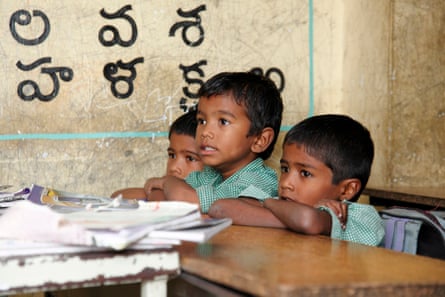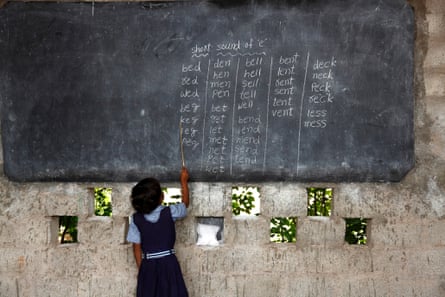Despite widespread concern about the effects of corporal punishment on children, it persists in schools across the world. Its eradication in many countries is proving difficult, and India is no exception.
Violence against girls is now high on India’s political agenda, after the horrific fatal gang rape of a female student in Delhi in 2012 led to demonstrations demanding an end to sexual violence against girls and women. However, more everyday forms of violence may go unnoticed or unquestioned, and limited academic attention has focused on gender differences in the way punishment is meted out to boys and girls at home, school, and society at large. For children in many parts of India, norms relating to femininity mean that girls are required to be docile and submissive, and not to be “naughty”. Ideas about masculinity may mean that boys are supposed to be able to accept physical punishment and to withstand pain.
India ratified the UN Convention on the Rights of the Child in 1992, and has many policies that ban corporal punishment in schools. But these seem out of kilter with everyday realities. The Right of Children to Free and Compulsory Education Act of 2009 guarantees school for all children between the ages of 6 and 14. Although elementary schooling has expanded, this rapid expansion has not been matched by comparable increases in the teaching workforce. There is a shortage of teachers across schools, and class sizes are very large, putting pressure on teachers to control high numbers of children.
The government of India commissioned research that included more than 3,000 children aged from 5 to 18, asking about physical abuse by teachers. In all age groups, 65% reported being beaten at school. Our own findings back up these figures. Younger children (aged 7–8) were significantly more likely to have witnessed and experienced corporal punishment than the 14- to 15-year-old cohort, with over two-thirds of the younger children having been physically punished at school in the past week, compared with one-third of the older young people. Poorer children were more likely than less poor children to be punished.
However, among children aged 14–15, we found that girls and boys alike experience routine corporal punishment, with boys experiencing particularly high levels. There was a less sharp distinction in use of corporal punishment between boys and girls in the younger cohort. This may be because corporal punishment is part of the socialisation of younger children, but when they are older it is no longer seen as an appropriate way to discipline young women, while “toughening up” young men may be normative.

It may be seen as part of boys’ socialisation and transition into adulthood. One 15-year-old boy complained about the unfairness of the beatings being meted out on boys, whom he perceived as being punished much more than girls. The violence children and young people experience in schools may not be visibly gendered but it may reinforce gender differentiation because of the ways in which it is employed by male and female teachers. Some children, for example, spoke of being particularly afraid of the male PE teachers. However, the reality is that young boys and girls alike are physically abused in schools, and it is being children that make them vulnerable, rather than their gender.
Reasons to be punished
Girls and boys spoke of a range of other reasons for punishment, including being absent from school due to work, illness or attending family celebrations, missing classes, not doing their homework, not reading well, making mistakes, receiving poor marks in exams, not wearing uniform, not having the right equipment, or not paying the teacher for extra lessons. One girl, aged 10, said:
“If we don’t study, they beat us. If we ask other children for help, they beat [us]. I went to drink water without asking sir, so he beat me that time. They said all children should come back to class by the time they count 10 after the interval. But I went home [to use the toilet]. After coming back to school, he beat me.”
Punished for poverty
Poverty at home also clearly influenced school discipline practices. Living in poverty meant that children were sometimes not in a position to follow the rules and expectations of school. Children described being punished for not having uniform or the right equipment, or money to pay fees.
One mother mentioned that the only thing her seven-year old daughter says about school is that teachers beat her:
“She studies well, she goes regularly and returns, but when there is no dress [uniform] and when we delay the fee payment then she will not go, she refuses to go ... she says she will not go and she hides behind that wall and says that ‘sir will beat me, they will beat me’.”

As Young Lives data have shown, economic constraints and family circumstances mean that boys and girls in rural areas engage in seasonal agricultural work on family land, and miss school for days, weeks, or months at a time. Although the boys and girls did different gender-specific work, the impact was the same: when they did return to school, they faced punishment. Although older boys rarely spoke directly about their fears of punishment, their mothers spoke of their sons’ emotions. Ranadeep’s mother explained:
“Without him, we cannot run the family, we don’t get labourers and there is no other way for us. When he returns to school they shout at him and he is terrified ... His father goes there and informs them ... they scold us, they say ‘how will he get on if he is absent for such a long time?’... We try to pacify them by telling them about our problems at home.”
What can be done?
In global policy debates, much emphasis has been placed on the role of education as the solution not only to reducing cycles of poverty in developing countries, but also to addressing gender violence.
However, the evidence presented here suggests that we must question this, at least in the Indian context. All children, regardless of gender, experience high levels of physical violence in schools. But it is teenage boys who experience the most.
But blaming specific groups (teachers, and/or parents) will not enable progress to be made, and risks alienating teachers already under pressure because of overcrowded classrooms, poor infrastructure, and poverty situations.
Approaches need to develop not only from the top down, but from communities, families and teachers to find ways of working together to change practices.
Violence as an integral part of schooling may have consequences for boys’ and girls’ development that go beyond the here and now of childhood to social and economic factors in adulthood. In India, this needs to be understood in the context of the high expectations that parents and children have of schools. Some children dislike school for many reasons, but if they discontinue school because of their experience of corporal punishment, and if they learn that corporal punishment is the solution to behaviour that is out of line, then formal schooling may inadvertently be reinforcing both cycles of poverty and the use of violence.
A longer version of this post was published on Young Lives’ Child Poverty and Development blog.
Virginia Morrow is a senior research officer at Young Lives and a University of Oxford associate professor. Follow @yloxford on Twitter.
Join our community of development professionals and humanitarians. Follow@GuardianGDP on Twitter.

Comments (…)
Sign in or create your Guardian account to join the discussion